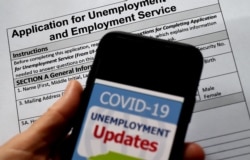The spread of the new coronavirus has brought attention to the sharp differences in how wealthy countries -- such as the United States and those in Europe -- take care of their citizens in hard times.
In Europe, the collapse of the economy has activated wage support programs that are keeping millions paid, for now. In the United States, more than 38 million people have sought unemployment financial assistance.
U.S. lawmakers have passed $2 trillion in emergency support, increasing assistance for the jobless and providing up to $1,200 for most taxpayers. Such steps happened in earlier economic crises, as well, especially the worldwide financial crisis and the Great Recession.
While European nations depend on existing programs to provide support, the U.S. depends on Congress to take action and pass emergency financial programs.
“In the U.S. you need to keep pumping money into the economy so that people continue to be employed, because it is through being employed that they are protected,” said Andre Sapir, an economist with the Bruegel research institute in Brussels, Belgium. “Which is the better system? I’m not going into that discussion because that is really a huge issue,” he added.
The United States usually is below average on measures of social support among the 37 countries of the Organization for Economic Cooperation and Development. The group’s members are mostly developed democracies.
The OECD reported last year that among its members the U.S. had the largest amount of people living in relative poverty, meaning living on half the average earnings. In the United States about with 17.8 percent of people live in relative poverty. In countries like Iceland, Denmark, the Czech Republic and Finland, fewer than 6 percent of people live on such earnings.
Here is a look at how the social safety nets of the U.S. and Europe compare:
Unemployment benefits
Americans on unemployment were collecting an average of about $372 weekly before the coronavirus appeared. The rescue plan gave jobless workers an additional $600 a week through July. It also extended support to those who lost work as a result of the coronavirus. Most states offer six months of unemployment, but the emergency legislation added 13 weeks.
Germany’s jobless benefit pays 60 percent of a worker’s past salary for one year. France provides up to 75 percent of the previous average daily wage for up to two years.
Europe also has short-hours programs, which pay most of a worker’s salary if companies put them on shorter hours. More than 10 million workers are being paid that way in Germany, and about 12 million in France.
Health insurance
Almost half of Americans receive health insurance through their employers. Another 34 percent get benefits through the government programs Medicare and Medicaid. Six percent are insured individually. Based on 2018 numbers, 9 percent had no insurance at all.
In Europe, nations mostly have universal health care. The systems are generally funded by taxes.
Parental benefits
The United States is the only country in the OECD to not offer paid leave to new mothers.
Federal law does not require private employers to provide paid family leave. Among private companies, 16 percent of workers were offered paid family leave as of March 2018. Some states offer paid family leave insurance for four to 10 weeks.
In France, mothers are offered at least 16 weeks of leave for their first child and must take at least 8 weeks. Workers get daily maternity leave earnings of up to 89 euros, or a little under $100. Some professions permit more favorable contracts, up to the full payment of earnings.
And Denmark gives 52 weeks of parental leave after a birth or adoption, to be shared by the parents. How much they earn depends on individual workplace agreements.
Disability benefits
An estimated 8.3 million Americans collect disability benefits earned through Social Security money. The payments average $15,100 a year — just above the poverty level. Requirements are hard to meet and most people seeking disability benefits are denied.
In France, fully disabled people can receive public health insurance payments of at least 292 euros, or $311, a month. Those who are unable to work and also depend on help for daily tasks may receive monthly payments of $1,500 to $3000.
The costs
Europe’s more expansive social safety nets come at a cost, largely paid through taxing workers and employers.
The total value of goods and services provided by a country is called its gross domestic product, or GDP. In the United States, 6 percent of the GDP in 2018 was social security payments, the OECD reports. In France, the amount was 16 percent. And, social security payments accounted for 14 percent of Germany’s 2018 GDP.
I’m Ashley Thompson.
The Associated Press reported this story. Ashley Thompson adapted it for VOA Learning English. Caty Weaver was the editor.
_______________________________________________________________
Words in This Story
institute - n. an organization created for a particular purpose (such as research or education)
society - n. people in general thought of as living together in organized communities with shared laws, traditions, and values
safety net -n. something that provides security against misfortune or difficulty
benefit -n. something extra (such as vacation time or health insurance) that is given by an employer to workers in addition to their regular pay
salary -n. an amount of money that an employee is paid each year
previous -adj. immediately before in time or order
insurance -n. an agreement in which a person makes regular payments to a company and the company promises to pay money if the person is injured or dies, or to pay money equal to the value of something (such as a house or car) if it is damaged, lost, or stolen
adoption -n. the act of taking a child of other parents legally as your own child
task -n. a piece of work










